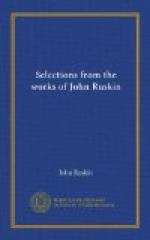Think for a little while of that scene, and the meaning of all its small formalisms, mixed with its serene sublimity. Estimate its secluded, continuous, drowsy felicities, and its evidence of the sense and steady performance of such kind of duties as can be regulated by the cathedral clock; and weigh the influence of those dark towers on all who have passed through the lonely square at their feet for centuries, and on all who have seen them rising far away over the wooded plain, or catching on their square masses the last rays of the sunset, when the city at their feet was indicated only by the mist at the bend of the river. And then let us quickly recollect that we are in Venice, and land at the extremity of the Calla Lunga San Moise, which may be considered as there answering to the secluded street that led us to our English cathedral gateway.
We find ourselves in a paved alley, some seven feet wide where it is widest, full of people, and resonant with cries of itinerant salesmen,—a shriek in their beginning, and dying away into a kind of brazen ringing, all the worse for its confinement between the high houses of the passage along which we have to make our way. Over-head, an inextricable confusion of rugged shutters, and iron balconies and chimney flues, pushed out on brackets to save room, and arched windows with projecting sills of Istrian stone, and gleams of green leaves here and there where a fig-tree branch escapes over a lower wall from some inner cortile, leading the eye up to the narrow stream of blue sky high over all. On each side, a row of shops, as densely set as may be, occupying, in fact, intervals




